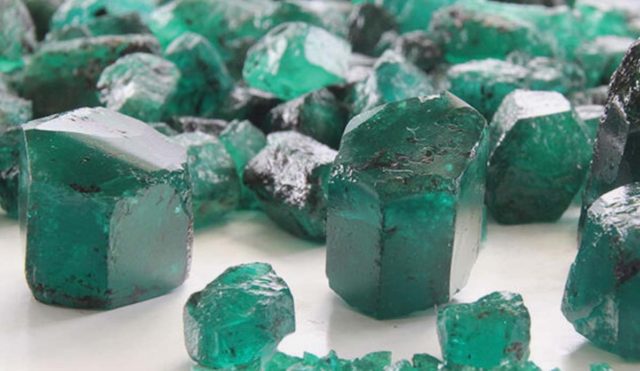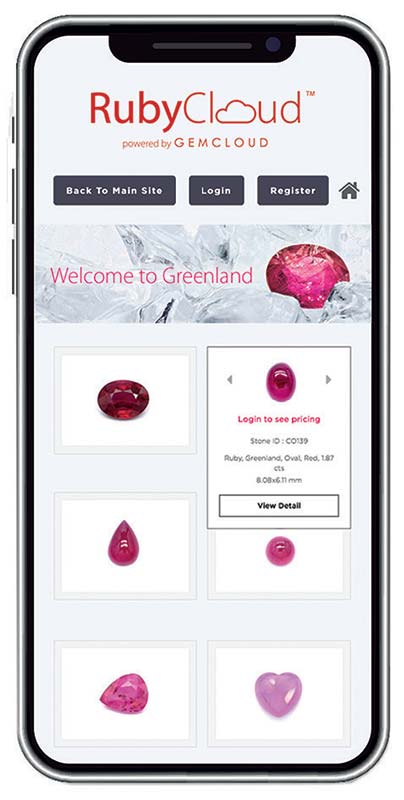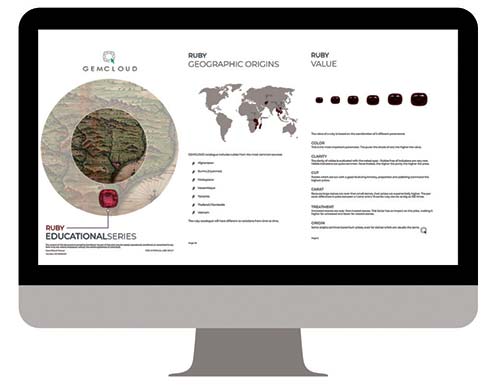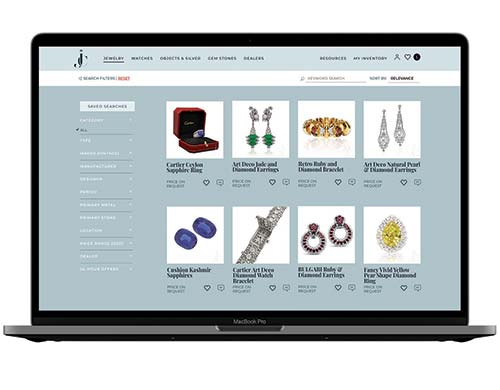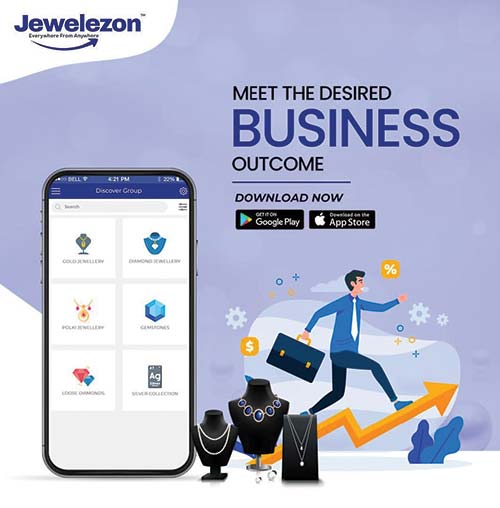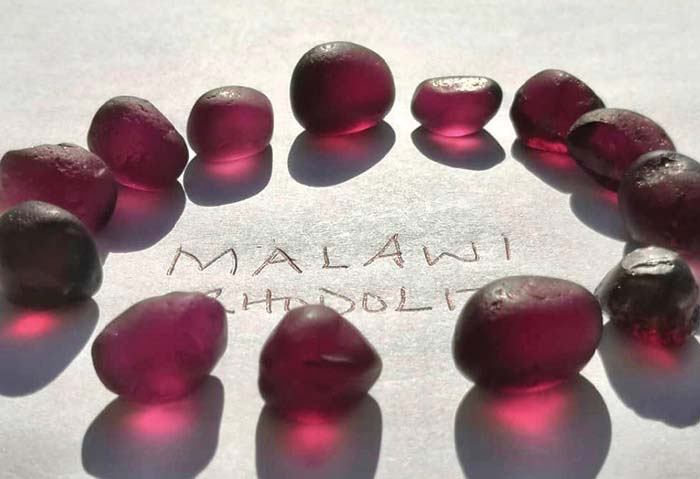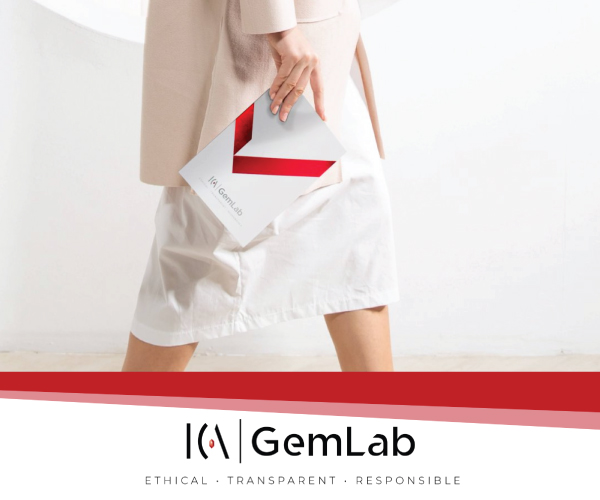Estimated reading time: 16 minutes
It is not the strongest of the species that survives, nor the most intelligent, it is the one that’s the most adaptable to change.
Charles Darwin
Since time immemorial, the art and science of acquiring a gem or a piece of jewelry has been about training the eye to look for quality, examining the craftmanship, and experiencing the magic of the jewel. The pandemic brought that to a grinding halt. According to various media sources, during the global lockdown in 2020, over three billion people were confined to their homes. Unable to access the real world, they started living online. Mobile applications, videotelephony and online chat services became essential tools.
With postponement of trade shows turning into full-blown cancellations, many in the industry found time to reorganize their inventory, revamp that crusty old website or open an Instagram account. But digitization was not just about staying connected or visible, generating revenue was key. Many online solutions mushroomed. A year later, a few seem to be gaining ground.
DIGITAL SALES PLATFORMS
(in alphabetical order)
Gembridge
After successfully selling their global digital advertising firm, technologist Mark Taylor and digital entrepreneur Nick Marrett were taking a much-deserved break when they met Tony Brooke, a seasoned professional with 40 years of experience, from mine to market in the colored gemstone industry. That first meeting in 2018 gave birth to Gembridge a year later.
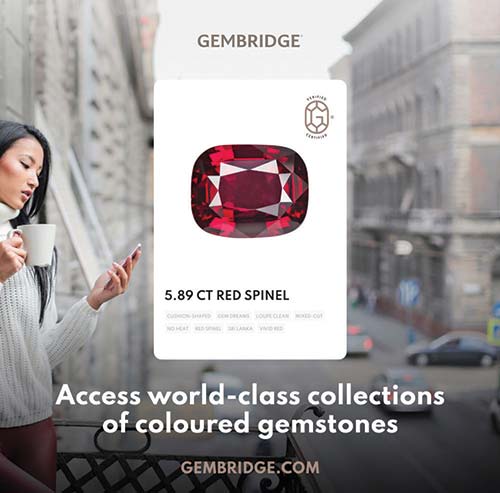
Launched in July 2020, with Brooke as Chairman, Gembridge offers universal access to high quality stones for a community of buyers, sellers and consignees, currently around 550 in 50 countries. Membership is free and trading is supported by a door-to-door service that is secure and insured.
The Gembridge community is fully verified and peer reviewed. During a transaction, Gembridge collects payment upfront and can issue Verification Reports that match sold stones to their listings before shipping. Each transaction via Gembridge attracts a commission, which serves as revenue for the platform.
Sharing his experience, John Ball, Managing Director of the large jewelry manufacturer Brown & Newirth, explains, “We supply jewelry to over 400 retailers across the United Kingdom. While the bulk of our collection features diamonds, under our bespoke service, we offer clients special gemstones, traditionally sourced from our trusted dealer network. Recently, we received an enquiry for a significant green sapphire. After exhausting our conventional sources, we contacted Gembridge. Within days our team received two options, and we were successfully able to select one, resulting in a delighted customer. The ease of the search functionality on the platform and the professional setup was refreshing. Based on this experience, next time we have a gemstone requirement, Gembridge will be the default option instead of the last resort.”
As the platform gained ground, jewelry and gem expert Helen Molesworth joined in December 2020 as Head of Business Development. There are 15 Gembridge Ambassadors, industry experts, who represent key trading markets and support members through Gembridge Hubs.
As explained by Marrett, who leads Gembridge as CEO, all members must agree to the Gembridge Charter to ensure the highest ethical trading standards, and a comprehensive disclosure and listing policy that standardizes cataloguing, listing descriptions and acceptable treatments.
Gembridge is a commercial member of the World Jewellery Council (CIBJO), International Colored Gemstone Association (ICA), and the Responsible Jewellery Council (RJC). It is regulated by Singapore’s Ministry of Law for purposes of antimoney laundering and countering the financing of terrorism.
A more personalized platform update has been released for Gembridge’s trade members and the company has also launched a service aimed at consumers.
GemCloud
After spending several years working in the colored gemstone business in Madagascar and Mozambique, Philippe Ressigeac teamed up with Mariaveronica Favoroso and Noah Severs to create the GemCloud Group. Favoroso brought her business management and luxury experience, while Severs delved into his domain knowledge of jewelry manufacturing and technology. Together with other experts, they created a comprehensive suite of tools, designed to support the colored gemstone industry in its digital transformation.
Their first product, a robust inventory management system called GemCloud. As per Ressigeac, GemCloud was the first platform (established April 2019) to focus in detail on the requirements of colored gem manufacturers and merchants. Users can upload their inventory, attach images and videos to each item, quickly navigate a vast repository, split and merge parcels, and track each stone from rough to finish.
Customers can also raise invoices, keep an eye on pending payments via accounting tools, and manage their businesses through detailed reports. The software includes sales support aids such as interactive quotes, and multi-level pricing for different customers.
GemCloud Group offers multiple sales tools to its customers: gemstone traders and mining companies can sell their gemstones via their online (B2B) marketplace. The company can also connect clients with GemCloud powered marketplaces (through their white label service) that, according to their team, will allow merchants to sell while they sleep.
Customers can build their own ecommerce website using the software. For example, mining company Greenland Ruby has built their business-to-business sales platform, called RubyCloud, using the GemCloud operating system. When lockdowns and travel restrictions started, being on GemCloud enabled Greenland Ruby to fast track the development of their virtual showroom, providing customers a seamless, user-friendly buying experience. A convenient solution, supported by high-resolution visuals, empowered Greenland Ruby to institute new consignment policies governed by their strict track-and-trace regulations. Their customers are given 14 days to inspect and approve their purchase or return the goods for a full refund.
Jewelers Circle
Heavily dependent on in-person inspections to mitigate the risk of fraud and ascertain value, the antique and vintage jewelry segment came to a standstill last year due to trade show cancellations and travel restrictions. Subsequently, senior industry players from the International Antique Jewellery Association (IAJA) banded together to develop a B2B marketplace named Jewelers Circle.
The founders realized that speed was of the essence and opted to launch with basic functionality, introducing new features every quarter as momentum increased. Membership is restricted to known merchants and firms, providing confidence to buyers and sellers. Since the founders are also active participants, Jewelers Circle operates as a private network, and transactions attract zero commissions.
Visitor subscribers (professionals such as retailers that are using the platform for sourcing only) pay one dollar for membership. Exhibitor members can create virtual stores on the platform to show their inventory, like a booth in a physical exhibition. The platform offers search capabilities either by dealer name, category, era (Art Deco, Art Nouveau), material, to name a few.
Members can also access regularly updated educational content. Besides jewelry, other verticals within the Circle include gemstones, timepieces, objects, and diamonds.
A year later, Jewelers Circle has 500 users, of which 200 are exhibitors who, as of July 2021, started paying $3,000 per annum or $300 per month as subscription fees. Interestingly, 10% of the revenue received will be set aside for distribution to loyal members.
Jewelezon
India’s Ministry of Commerce and Industry estimates that the market size of the country’s gem and jewelry sector will reach US$100 billion by 2025. Before Covid, the region’s voracious appetite was quenched via trade exhibitions where buyers and sellers converged to examine, negotiate, learn, and transact.
Worried about potential conflict with their industry customers, many manufacturers felt uncomfortable with social platforms such as Instagram and concerned that creating a B2B online inventory of stock would require time and investment. It was in this mercurial environment that Dhananjay Kapoor created an app called Jewelezon, positioning it as a closed-circuit social networking space for verified players from the jewelry industry.
Kapoor explains, “We adopted a systematic approach and got certified as a start-up by the Ministry of Commerce, Government of India. Our app enabled gem and jewelry manufacturers, exporters, importers, and retailers in India (and beyond) to view jewelry collections virtually from any hand-held device as they would have done in a physical show.”
With a user base of 900+ verified members (and growing), Jewelezon has been a lifesaver for jewelry manufacturers and retailers. The application is available for free download on the Google play store and iOS store.
Virtu Gems
Moving from the world of merchants to artisanal miners, we arrive at the doorstep of Virtu Gems. With the cancellation of the Africa Gem Exhibition and Conference (AGEC), originally scheduled for October 1-3, 2020, artisanal miners approached the organizers seeking an alternative route to market.
This led US-based jewelry designers Susan Wheeler, Jessica Hudson, and Kenya-based artisanal mining advocate Monica Gichuhi to create Virtu Gems: an online platform that offers gemstones direct from verified artisanal miners working in Malawi, Zambia, and Kenya.
The platform also features four gem cutters based in Africa who are responsible for the facetted gems on virtugems.com. Their online shop offers rough and cut gemstones, as well as mineral specimens that they market as healing crystals, and a separate category for gemstones sold by women.
Virtu Gems is housed as a project under The Responsible Jewelry Transformative, a non-profit established by co-founder Susan Wheeler.
ONLINE AUCTIONS
One of the first slices of positive news in April 2020 were results from auction houses Christie’s and Sotheby’s. Leveraging their experience in online auctions, both were swift in reacting to lockdowns in 2020 by introducing new digital tools and a more interactive online experience.
According to Sotheby’s, their investments in technology broadened their universe of buyers and transformed their engagement style: a proprietary online bidding platform, livestreamed auctions, an immersive digital catalogue, interactive media, online appraisals, live chat, virtual galleries, and other rich content formats. New digital tools with innovative multichannel business models increased Sotheby’s reach globally and maximized flexibility for its customers. Participants in the online auctions in 2020 came from 100 countries, with 44% of bidders new to Sotheby’s (up 13% from the previous year). Further, 30% of participants in online sales were aged under 40.
Over at Christie’s, we saw a similar result. Its release of 2021 sales figures showed a 13% increase in the first half of the year, when compared with pre-pandemic results during the same period. Leading the charge were Asian buyers representing 39% of total sales value (followed by EMEA at 33% and the Americas at 28%). Not surprising, considering Asia Pacific is one of the fastest growing regions for mobile internet users, and home to over half of total global subscribers—2.8 billion in 2019, slated to reach 3 billion by 2025, according to the GSM Association.

Auction houses weren’t alone in their reliance on digital solutions. Mining companies such as Belmont Emeralds from Brazil and Gemfields from Africa also switched to online bidding from their previous in-person auction models.
Belmont opted to work with the Bonas Group; the largest independent diamond and colored stone tender house that offers a comprehensive suite of services including sorting and valuation of run-of-mine production, marketing, and sales via their proprietary online bidding platform. Tim Denning from the Bonas Group explains, “Belmont’s clients could view the mine’s production safely and securely at the tender facility of the Dubai Multi Commodities Centre (DMCC) following their strict Covid protocols.” Once bidders viewed the lots on offer, they could (at their convenience) go online and place their bids before the deadline.

For Gemfields, things were more complicated. 93% of total group revenue for Gemfields pre-Covid was via in-person auctions of its emeralds from Zambia and rubies from Mozambique. Almost all auctions were conducted in Singapore, a convenient destination for its customers from India and Thailand.

But in March 2020, due to Covid, Singapore closed its borders, effectively turning off Gemfields’ revenue tap. Although its product team had been working on an online auction platform, they were eight to ten months away from launch. As lockdowns led to mine closures in Africa, completing the online platform’s development became a priority for Gemfields.
In Q4 2020, the company conducted a series of mini-emerald auctions, with in-person viewings in multiple locations. The bidding took place via its new online platform (customized by BidGemmer), permitting customers from various jurisdictions to participate in a sealed-bid process. Adrian Banks, Gemfields’ Managing Director of Product & Sales explains, “We had over forty participants in our first online auction, a great turnout. It was encouraging to see that every single one of our Jaipur-based customers were comfortable to bid online, something we had previously thought would be a challenge.” Encouraged by the success of the mini-auctions in 2020, full-scale emerald and ruby online auctions were conducted by Gemfields in March and April of 2021. These generated revenues of US$31.4 million from the emerald auction and US$58.9 million from the ruby auction (the third-highest auction result to date).
But how much did digitalization influence bidding? Pre-Covid, bidders at the Gemfields ruby auction would move from one booth to the next to examine the schedules. Now, the Gemfields team brought them requested ruby schedules. Most preferred this as it enabled a better understanding of the material (thanks to simultaneous comparisons and extra time), but they lost the opportunity to observe their competitors and gather market intelligence, such as the frequency of visits to a particular booth by specific bidders.
ONLINE EDUCATION & NETWORKING
The pandemic also resulted in the democratization of content, contacts, and an inclusive approach to education. The first platform the gem and jewelry community turned towards to stay connected, visible and engaged with potential customers was Instagram.
Influencers, journalists, and storytellers started conducting Insta-LIVE broadcasts interviewing designers, as well as gem and vintage jewelry merchants who welcomed virtual audiences into their never-seen-before ateliers.
According to advisory firm KEPIOS, social media users grew, in 2020, at the fastest rate in three years to 4.2 billion. The first tranche of broadcasts created a ripple effect activating other avenues that enabled miners, manufactures, dealers, and gem and jewelry lovers to stay intellectually and spiritually stimulated.
While Instagram provided an opportunity to interact, and be edu-tained, Zoom created more structured learning opportunities. The pandemic removed the velvet ropes as experts worldwide started sharing their immense knowledge via presentations and detailed discussions that previously would only be accessible via closed-door industry conferences or courses.
De Beers unlocked its diamond courses along with the worldrenowned SSEF removing the fees for their colored gemstone online classes. The Gemological Institute of America (GIA), the World Jewellery Confederation (CIBJO), and L’ÉCOLE School of Jewelry Arts in Paris have been regularly hosting free educational presentations. YouTube became a virtual library as organizers generously made the content freely available for posterity.
Lurking in the shadows was a sense of mortality, which prompted others like field gemologist Vincent Pardieu to interview senior veterans documenting their experiences. This resulted in two precious interviews with Jean Claude Michelou (gem merchant, former editor of InColor, and treasured member of the community) before his tragic passing due to Covid-related causes in April 2021.
The first platform the gem and jewelry community turned towards, to stay connected, visible and engaged with potential customers was Instagram.
Unable to meet, social community clubs such as New Yorkbased Gem X went virtual, creating a series of online jewelry presentations cleverly titled GEMFLIX. The digital move transformed Gem X into a worldwide network beyond the expectations of founders Lin Jamison and Heidi Garnett. In a short period, the newcomers swiftly built a loyal community of experts and enthusiasts, a feat that may have traditionally taken years. GemX generate revenue from subscription and event fees and have raised over US$32,000 for charity.
Digitalization of educational content continued with the launch of the Understanding Jewellery (UJ) platform by senior industry players David Bennett and Daniela Mascetti, based on 40 years of their work as Worldwide Chairman and European Chairman respectively of Sotheby’s Jewellery Division. Named after the international bestselling book by the founders, which many consider a jewelry bible, the website offers subscription-based access to the wealth of knowledge contained within the cerebral vaults of David and Daniela. For those looking for a deeper dive, structured online courses are available, led by the founders via real-time virtual classes.
Stretching the literary experience beyond the digital realm, Bennett and Mascetti have also curated travel experiences to Burgundy, Paris, London and Jaipur. Under Discover & Collect, they present their selection of rare and highly collectable jewels and gemstones.
As the world recalibrated, it magnified the desire to buy and source responsibly. Gem dealers and jewelers increasingly started receiving requests from customers asking about a stone’s provenance. Some opted for self-assessment tools and industry-aided attestations; others picked up the pace to complete their membership of more formal organizations such as the Responsible Jewelry Council (RJC).
In April 2021, members of the Coloured Gemstones Working Group (Gemfields, LVMH, Chopard, Tiffany & Co, Swarovski, Richemont, MUZO mining company, and Kering) launched the Gemstones and Jewelry Community Platform: an initiative to provide free resources and tools to allow members to learn more about key sustainability areas and implement best practices within their business. Sharing his thoughts on the platform as a new member, Australian jewelry designer Alexander Wilson explains, “The pandemic provided me the time I needed to create an online presence for my business and increase my Insta activity. The digital outreach brought new customers but also new questions I felt I couldn’t answer. The CGJCP platform has been fantastic for me to learn more about sustainability, responsible sourcing, and related topics. In a world where we can endlessly google topics and opinions, it is reassuring to have so much information to work through in one place without any fees.”
As industry stakeholders navigate the new normal, they lean on previously overlooked and new digital tools. Given the complexities surrounding colored gemstones, travel and in-person experiences will always hold considerable value. But digitalization is disrupting and recalibrating the very nature of the industry, causing fundamental changes from which there will be no coming back.
Photos are courtesy of the company mentioned.



